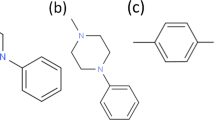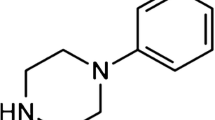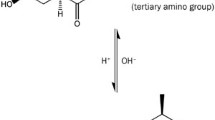Abstract
The relationship between structure and permeability of peptides across epithelial cells was studied. Using confluent monolayers of Caco-2 cells as a model of the intestinal epithelium, permeability coefficients were obtained from the steady-state flux of a series of neutral and zwitterionic peptides prepared from D-phenylalanine and glycine. Although these peptides ranged in lipophilicity (log octanol/water partition coefficient) from −2.2 to +2.8, no correlation was found between the observed flux and the apparent lipophilicity. However, a strong correlation was found for the flux of the neutral series and the total number of hydrogen bonds the peptide could potentially make with water. These results suggest that a major impediment to peptide passive absorption is the energy required to break water–peptide hydrogen bonds in order for the solute to enter the cell membrane. This energy appears not to be offset by the favorable introduction of lipophilic side chains in the amino acid residues.
Similar content being viewed by others
REFERENCES
P. S. Burton, R. B. Hill, and R. A. Conradi. Metabolism and transport of peptides across the intestinal mucosa. Proc. Int. Symp. Control. Rel. Bioact. Mater. 14:6–7 (1987).
N. F. H. Ho, J. S. Day, C. L. Barsuhn, P. S. Burton, and T. J. Raub. Biophysical model approaches to mechanistic transepithelial studies of peptides. J. Control. Release 11:3–24 (1990).
W. D. Stein. The molecular basis of diffusion across cell membranes. In The Movement of Molecules Across Cell Membranes, Academic Press, New York, 1967, pp. 65–125.
I. J. Hidalgo, T. J. Raub, and R. T. Borchardt. Characterization of the human colon carcinoma cell line (Caco-2) as a model system for intestinal permeability. Gastroenterology 96:736–749 (1989).
G. Wilson, I. F. Hassan, C. J. Dix, I. Williamson, R. Shah, and M. Mackay. Transport and permeability properties of human Caco-2 cells: An in vitro model of the intestinal epithelial cell barrier. J. Control. Release 11:25–40 (1990).
A. R. Hilgers, R. A. Conradi, and P. S. Burton. Caco-2 cell monolayers as a model for drug transport across the intestinal mucosa. Pharm. Res. 7:902–910 (1990).
A. I. Vogel. A Textbook of Practical Organic Chemistry, Longmans, Green and Co., London, 1959.
A. H. Lewin, M. Frucht, K. V. J. Chen, E. Benedetti, and B. D. DiBlasio. Restricted rotation in amides VI. Configurations and conformations of unsymmetrical tertiary benzamides. Tetrahedron 31:207–215 (1975).
N. F. H. Ho, J. Y. Park, P. F. Ni, and W. I. Higuchi. Advancing quantitative and mechanistic approaches in interfacing gastrointestinal drug absorption studies in animals and humans. In W. Crouthamel and A. C. Sugars (eds.), Animal Models for Oral Drug Delivery in Man, Am. Pharm. Assoc., Washington, DC, 1983, pp. 27–106).
E. M. Renkin. Filtration, diffusion and molecular sieving through porous cellulose membranes. J. Gen. Physiol. 38:225–238 (1954).
H. Westergaard and J. M. Dietschy. Delineation of the dimensions and permeability characteristics of the two major diffusion barriers to passive mucosal uptake in the rabbit intestine. J. Clin. Invest. 54:718–732 (1974).
J. M. Diamond and E. M. Wright. Molecular forces governing non-electrolyte permeation through cell membranes. Proc. Roy. Soc. B 172:173–316 (1969).
J. L. Madara. Loosening tight junctions. J. Clin. Invest. 83:1089–1094 (1989).
N. Lakshminarayanaiah. In Equations of Membrane Biophysics, Academic Press, New York, 1984.
G. O. Rose, A. R. Geselowitz, G. J. Lesser, R. H. Lee, and M. A. Zehfus. Hydrophobicity of amino acid residues in globular proteins. Science 229:834–838 (1985).
I. M. Klotz and S. B. Farnham. Stability of an amide-hydrogen bond in an apolar environment. Biochemistry 7:3879–3882 (1968).
M. A. Roseman. Hydrophilicity of polar amino acid side-chains is markedly reduced by flanking peptide bonds. J. Mol. Biol. 200:513–522 (1988).
J. M. Diamond and Y. Katz. Interpretation of nonelectrolyte partition coefficients between dimyristoyllecithin and water. J. Membr. Biol. 17:121–154 (1974).
M. A. Roseman. Hydrophilicity of the peptide CO ¨ NH hydrogen-bonded group. J. Mol. Biol. 201:621–623 (1988).
R. C. Young, R. C. Mitchell, T. H. Brown, C. R. Ganellin, R. Griffiths, M. Jones, K. K. Rana, D. Saunders, I. R. Smith, N. E. Sore, and T. J. Wilks. Development of a new physicochemical model for brain penetration and its application to the design of centrally acting H2 receptor histamine antagonists. J. Med. Chem. 31:656–671 (1988).
Author information
Authors and Affiliations
Rights and permissions
About this article
Cite this article
Conradi, R.A., Hilgers, A.R., Ho, N.F.H. et al. The Influence of Peptide Structure on Transport Across Caco-2 Cells. Pharm Res 8, 1453–1460 (1991). https://doi.org/10.1023/A:1015825912542
Issue Date:
DOI: https://doi.org/10.1023/A:1015825912542




